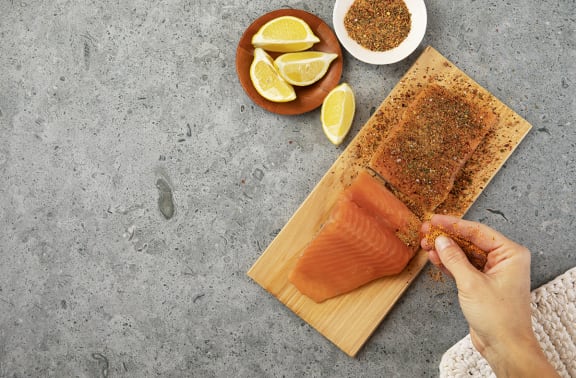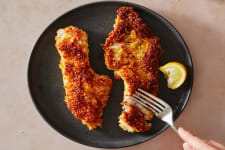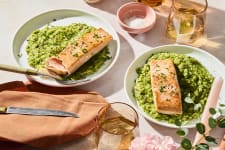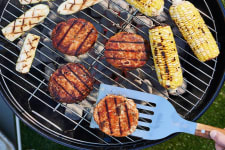Wild-caught seafood and cedar plank cooking are a culinary duo that every home cook should get to know. Personally, we love the idea of cooking something from the wild on a little slab of nature.
There are also three really good, practical reasons to use a cedar plank to prepare your seafood:
1. Cedar plank cooking will make high-quality seafood taste better than it already does.
2. It’s a cooking technique that seems fancy, but is virtually foolproof, even for beginners!
3. Your meal is going to look fiiiiine when it comes off the grill or out of the oven.
Here’s everything you need to know about cooking wild-caught seafood on a cedar plank:
A Little Background on Cedar Plank Cooking
The tradition of cedar plank cooking originates in the Pacific Northwest among Native American tribes. It was used around an open campfire as a way to prepare food — a different setup than the one we use in our backyards or in our home kitchens. The technique has of course been adapted and remixed to fit contemporary needs.
One thing that hasn't changed is the fact that cedar plank cooking is the perfect fit for wild-caught seafood. Cooking wild-caught fish and shellfish on cedar planks imparts complex, savory aromas onto the seafood, enhancing the flavors of the meal. In addition, because the cedar planks are soaked in water before being heated up, they produce a fragrant steam that gently cooks your food to tender perfection.
How to Cook with Cedar Planks: The Basics
-
Soak cedar plank — an hour if grilling, or 15 minutes if baking.
-
Place wild-caught seafood on wet plank.
-
Place plank on preheated grill or in preheated oven.
-
Cook as directed in recipe.
How to Soak a Cedar Plank
The first rule of cedar plank cooking is that the planks need to be soaked in water, fully submerged. (Alternatively, you can play around by soaking the plank in another aromatic liquid of your choice — wine, cider, sake.) Weight the planks down with a heavy object if you need to. Soaking the plank allows it to get steamy, and it also helps to prevent the cedar plank from catching fire on the grill as it heats up. A flare-up not only can be dangerous, but it can also char any of the food that is cooking on the plank.
For the grill
If you’re planning to use your cedar plank on a grill, soak for 1-2 hours in any temperature water. It’s important to soak through so that the wood doesn’t catch fire when it comes into contact with open flame.
For the oven
If you’re planning to bake with your plank, soak your plank for 15 minutes in hot water. When baking with a cedar plank, it needs significantly less time to soak, as it won’t be in close contact with an open flame.
Pro tip: Cedar planks can be soaked ahead of time, then frozen for future use. Freezing the planks locks in the water that they’ve absorbed. Store soaked planks in a large freezer bag until ready to use. To thaw a frozen cedar plank, all you need to do is leave it at room temperature for about 10 minutes, then use as you normally would.
How to Grill with a Cedar Plank
Before you do anything with an open flame on the grill, make sure you have a spray bottle with water nearby. You may not need to use it, but you will want to have one by your side to extinguish any little fires that threaten to singe the cedar plank or burn your seafood.
1. Set up your grill so that you’ll be able to place the cedar plank over indirect heat. Do this by only loading one side of the grate with coals. If you’re using gas, turn half the burners up to medium-high and leave the other burners off. Basically, you want to leave enough space on the grill for the cedar to steam rather than to singe over a flame.
2. Allow the grill to preheat to about 400F.
3. Meanwhile, brush the top of your cedar plank with a little bit of high heat cooking oil, then place your prepped seafood on it. If you’re cooking a skin-on fish like sablefish or wild salmon, make sure it’s skin-side down.
4. When the grill is hot, place plank on the cooler side of the grill, then close the grill lid and allow the food to cook per your recipe’s instructions. Cook times will vary depending on the type of seafood you’re using.
How to Bake with a Cedar Plank
Don’t have access to a grill? You can use your oven to cook with a cedar plank. The flavor of the wood won’t come through quite as prominently when baking with a cedar plank, since there won’t be an open flame in your oven, but the plank will still produce plenty of aromatic steam as it heats up, and will keep your fillet impossibly moist.
1. Preheat the oven to 450F.
2. Meanwhile, brush the top of your cedar plank with a little bit of cooking oil, then place your prepped seafood on it. If you’re cooking a skin-on fish like sablefish or wild salmon, make sure it’s skin-side down.
3. Place cedar planks on a rimmed baking sheet, then bake per your recipe’s instructions. Cook times will vary depending on the type of seafood you’re using.
Can You Reuse a Cedar Plank?
Yes, as long as the cedar plank looks like it’s in good condition, it can be reused. Good condition means that it can be cleaned without soap and that the plank hasn’t been excessively burnt. Typically, you can expect to be able to reuse a cedar plank up to three times.
How to Clean a Cedar Plank
To clean a cedar plank, use warm water and scrub brush to scrape any particles of food from the board. Do not use soap, as this will leave a soapy flavor behind for the next time you use the board.
Let the board dry out completely in a well-ventilated, sunny area to ensure that it doesn’t pick up any mold. Reuse as normal.
Which Types of Seafood to Cook on Cedar Planks
You can cook any type of seafood on a cedar plank, but you’re going to get the most aromatic, cedar-y results when you’re cooking with full fillets. That’s because these cuts take at least 10 minutes to cook, and that means they’ll have at least 10 minutes to absorb fragrant steam from the planks.
If you’re cooking something quick-cooking like spot prawns or scallops on a cedar plank, they’ll steam to tender perfection, but the cedar flavor will be much more subtle, if not imperceptible. On the grill, they’ll probably pick up some smokiness, but the other flavors you use to cook them will be much more prominent.
Seafood and Cedar Plank Recipe Ideas
Here's an easy cedar plank salmon recipe that's the perfect balance of sweet, spicy, tangy, and smoky, thanks to a dusting of Ras el Hanout and a glaze of pomegranate syrup.
For a more delicate flavor profile that's kissed with smoke, try our recipe for cedar plank halibut, smothered in a creamed leek topping.
If you're more of a no-recipe recipe type of cook, you can toss peeled spot prawns in olive oil and your favorite spice blend — try Old Bay or jerk seasoning — and cook them for about 6 minutes on the grill or in the oven until they're just opaque through the centers.






